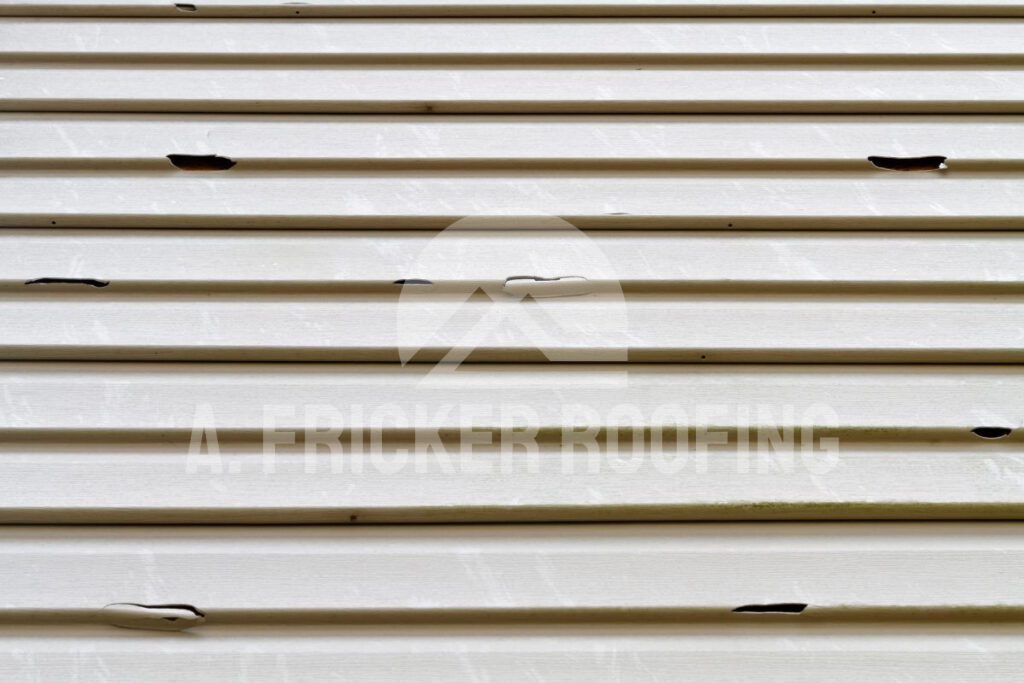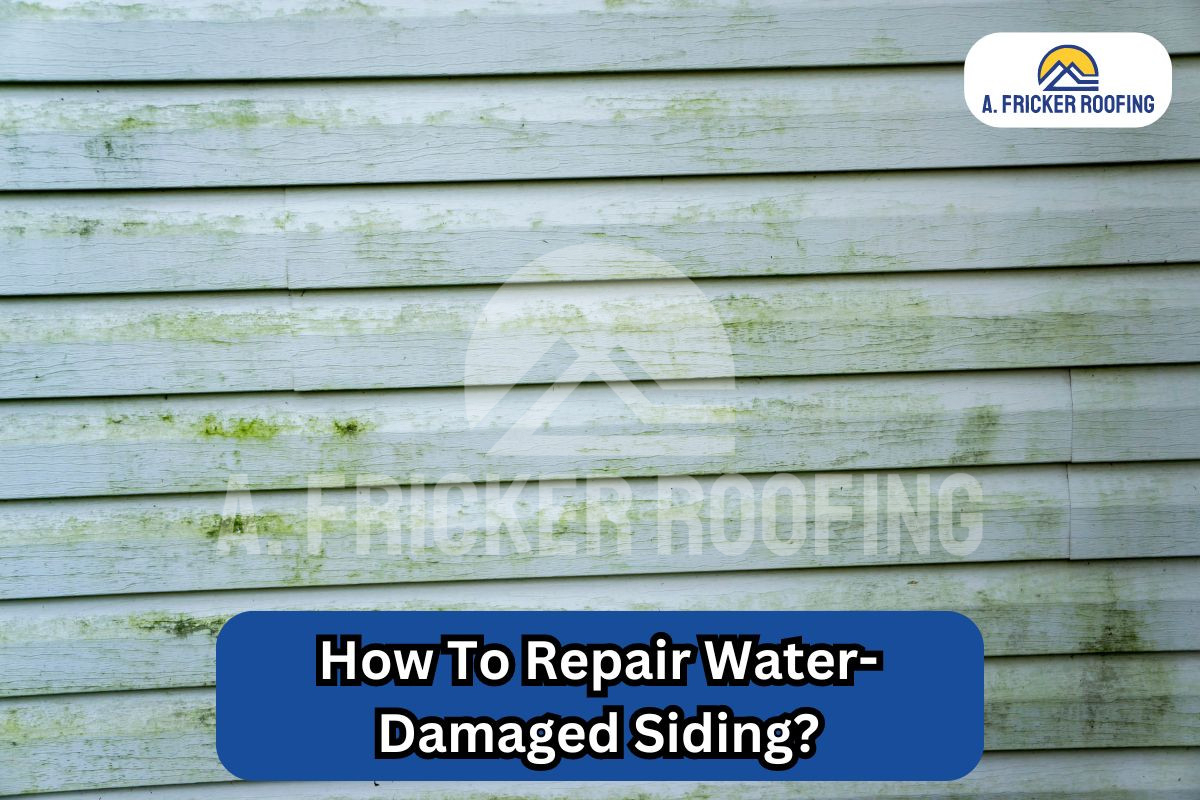Water can cause serious problems to the siding of your home, which can result in costly repairs if left unaddressed. The good news is that with early detection and prompt action, you can often fix the damage yourself and prevent further deterioration.
At A. Fricker Roofing and Waterproofing, we provide home and business owners with valuable information about their properties. This guide will walk you through identifying, assessing, and repairing water-damaged siding, along with tips on preventing future issues.
How Do You Know If You Have Water-Damaged Siding?
The first step in tackling water damage is knowing what to look for. Different siding materials might show different kinds of damage from water.
- Wood siding is pretty susceptible to water damage. It can rot, swell, or develop a spongy texture when it’s been exposed to too much moisture.
- Vinyl siding might not rot, but it can warp, buckle, or develop cracks if water gets trapped behind it.
- Fiber cement siding is tougher against water, but it can still show signs of damage like swelling or crumbling if water manages to penetrate it.
- Even brick and stone siding can suffer from water damage, usually showing up as cracks, crumbling mortar, or efflorescence (the white, chalky stains you might see).
No matter what kind of siding you have, catching water damage early is key to avoiding big, expensive repairs down the line. That’s why it’s a good idea to give your siding a once-over at least once a year or after any big storms that blow through Tulsa, Oklahoma.
Assessing the Extent of Water Damage on Your Siding
Once you suspect water damage, it’s important to figure out how bad the problem is. Knowing the extent of your water-damaged siding allows you to make an accurate decision between DIY or a professional repair.
- Safety should be your top priority when inspecting damaged siding. Make sure to wear gloves, safety glasses, and a dust mask to protect yourself.
- You’ll need a few tools to properly assess the damage, including a screwdriver, a pry bar, and a moisture meter.
- To check for water damage, start by gently probing the affected area with a screwdriver. If the siding or the material underneath feels soft or spongy, that’s a sign of water damage.
- Use a moisture meter to measure how wet the siding and the underlying structure are. It’s also a good idea to look for signs of damage behind the siding, such as in the insulation, sheathing, or framing.
Major vs. Minor Water Damage
After assessing your siding for water damage, it’s important to understand the difference between minor and major damage, as this will determine the appropriate repair approach. Here’s a breakdown of what to look for:
Minor Water Damage
Minor water damage typically affects only the surface of the siding. You might notice small cracks, holes, or slight warping of individual siding pieces.
There could be some discoloration, peeling paint, or small areas of rot. This kind of damage is usually limited to a few boards or a small area of the siding.
Major Water Damage
On the other hand, major water damage is more severe and often extends beyond the siding itself. It can affect the underlying structure of your home, which is much more serious.
You might see extensive rot, large areas of warped or buckled siding, or damage that has penetrated through to the sheathing or framing beneath.
In cases of major water damage, you might notice significant gaps between siding pieces, large sections of missing or severely damaged siding, or even signs of water intrusion inside your home.
Repairing Minor Water Damage on Your Siding
If you’ve determined that the water damage to your siding is minor, you might be able to repair it yourself. Here’s how to tackle some common minor water damage issues:
Small Cracks & Holes

- For small cracks or holes in your siding, start by properly cleaning the damaged area with a mild detergent and water solution. This will remove any dirt or loose paint.
- Let the area dry completely before moving on. Next, use a caulk gun to apply exterior-grade caulk to the crack or hole. Allow it to dry completely per the application instructions.
Also Read: Signs of Hail Damage on Vinyl Siding and How to Fix Them
Larger Holes

For larger holes, you might need to use siding material filler instead.
- Use the material your existing siding has, such as wood filler for wood siding or vinyl patch for vinyl siding.
- Apply the material generously, slightly overfilling the damaged area to account for shrinkage as it dries.
- Allow the filler to dry completely, which generally takes about 24 to 48 hours, based on the product and weather conditions.
- Once it’s dry, use medium-grit sandpaper to smooth the repaired area until it’s flush with the surrounding siding. This will create an even surface.
- After sanding, apply an exterior primer to the repaired area. This helps the new paint stick better and provides extra protection against moisture.
- Finally, paint over the primed area with exterior paint that matches your siding color.
Replacing The Entire Board
The process is a bit more involved if you need to replace a few boards of your water-damaged siding.
- Start by carefully removing the damaged siding boards. Lift the nails very gently using a prybar, securing the board.
- Work slowly to avoid damaging the surrounding boards or the underlying structure. Measure the area where you removed the damaged boards and cut new siding boards to fit.
- Make sure you’re using the same type and style of siding for a seamless repair.
- Before installing the new boards, take a close look at the area underneath. Check for any signs of water damage or rot in the sheathing or framing.
- If you find any issues, it’s important to address them before proceeding with the siding replacement.
- Install the new siding boards, starting from the bottom and working your way up.
- Secure each board with galvanized nails, driving them through the nailing strip at the top of each board. Be careful not to drive the nails in too deep, as this can dimple the siding.
- Once all the new boards are in place, apply exterior-grade caulk to seal the seams between the new boards and the existing siding. This helps prevent water from getting in.
- If your new siding is not pre-painted or stained, apply primer to the new siding boards. This ensures better paint adhesion and longevity.
- Finally, paint the new boards to match the existing siding color. You may need to blend the edges of your paint job to create a uniform appearance.
How To Address The Major Water Damage On Your Siding?
The simple and straightforward answer is to hire a professional.
If you encounter extensive damage, have concerns about your home’s structural integrity, or notice a significant mold infestation, you should definitely consider hiring a pro. These issues can be complicated and may require specialized knowledge and tools to address properly.
When choosing a contractor to repair your water-damaged siding, it’s important to do your homework. Get several quotes from best-rated contractors to make sure you’re getting a fair price. You should also ask for recommendations from family and friends and check online reviews. It’s also crucial to verify that the contractor has proper insurance and licensing. This protects you from liability in case anything goes wrong during the repair process.
Preventing Future Water Damage to Your Siding
Preventing water damage is key to avoiding costly siding repairs in the future. Regular maintenance and inspections are very important for keeping your siding in good condition.
- Make it a habit to inspect your siding for signs of damage a few times a year. Look for cracks, gaps, or areas where the siding seems to be pulling away from the house. These can all be entry points for water.
- You need to keep your downspouts and gutters clean and in good condition. Clogged gutters will overflow and cause water to run down your siding, leading to damage over time. Make sure your downspouts direct water away from your home’s foundation.
- It’s also a good idea to trim any trees or shrubs that are close to your house. Overhanging branches can scrape against your siding, creating damage that can let water in.
- Improving the drainage around your home can also help prevent water damage to your siding. Make sure the soil around your foundation slopes away from the house. This helps water drain away from your home rather than pooling near the foundation. If you have persistent drainage issues, you might want to consider installing a French drain or swale.
- Applying protective coatings or sealants to wood siding can enhance its water resistance and help prevent future damage. These products create a barrier that repels water, helping to keep your siding dry even in wet conditions. To maintain their effectiveness, be sure to reapply these coatings according to the manufacturer’s recommendations.
Final Thoughts
Addressing water damage promptly is important for protecting your home’s structural integrity and value. Make it a habit to regularly inspect your home’s siding for signs of water damage and address any issues immediately. By following the tips outlined in this guide and maintaining your home’s exterior, you can prevent costly water damage and keep your siding looking its best for years to come.
Also Read: 5 Best Hail-Resistant Siding Options for Your Home
Hire the Best Rated Contractors For Siding Repair In Tulsa, OK
If you suspect water damage to your siding or have any other concerns, we are here to assist you. At A. Fricker Roofing and Contracting, we provide top quality siding services in Tulsa, OK, and the nearby areas.
We have an experienced team of professionals who can assess the damage, provide expert advice, and help you find the best solution for your needs. Call us today at (918) 402-7167 to know more about our services.

